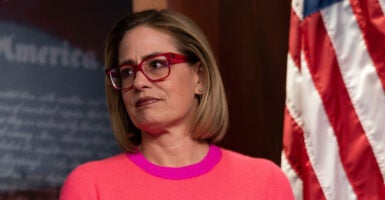When Senate Majority Leader Chuck Schumer, a New York Democrat, barks “Jump!” Sen. Angus King, a Maine independent, obediently asks, “How high?”
Despite a January 2021 puff-piece profile on CBS’ “60 Minutes” touting the Mainer’s supposed independence, the two-term King is an independent in name only. One is hard-pressed to recall the last time he didn’t vote in lockstep with Senate Democrats, with whom he caucuses.
He told “60 Minutes” that he ran for Maine governor in 1994 as an independent because he “didn’t feel comfortable with the Democrats on the taxation-regulation side” and “didn’t feel comfortable with the Republicans on the social-issues side.”
Since arriving in the Senate in 2013, however, King’s “comfort” level with the Democratic Party’s hard-left positions on taxation and regulation, as well as on social issues, has increased markedly, such that, according to FiveThirtyEight.com, the nominal independent has voted for President Joe Biden’s agenda 98.3% of the time.
Two states over, Vermont is home to the Senate’s (until now) only other nominal independent, Sen. Bernie Sanders, who also caucuses with Democrats.
Sanders thinks the Democrats aren’t far enough left, which accounts for his lower 91.4% vote-with-Biden score. But when push comes to shove, he always votes for whatever left-wing economic and social-cultural legislation Democrats devise, if only because four-fifths of a socialist loaf is better than no loaf at all.
On Dec. 9, King and Sanders were joined by a third independent, Sen. Kyrsten Sinema of Arizona, who renounced her Democratic Party affiliation.
Sinema’s degree of independence going forward, however, remains to be seen, inasmuch as her FiveThirtyEight.com pro-Biden score is 93.1%.
In fairness, however, that 6.9% disagreement does encompasses some big-ticket items, most notably the freshman Arizona senator’s adamant refusal to agree to abolish the Senate filibuster.
Had she (and Sen. Joe Manchin, a West Virginia Democrat) gone along with the rest of the Senate Democratic Caucus in voting to do away with the filibuster, one shudders to think what far-left legislation Democrats would have rammed into law on a purely party-line vote. (Think statehood—and two Democratic senators—for the District of Columbia.)
Sinema hasn’t said whether she would continue to actively participate in the Senate Democratic Caucus, although she did confirm she wouldn’t be caucusing with Republicans.
But to say her declaration of independence didn’t sit well with Democrats and liberals—in and out of the Senate—would be an understatement.
Appearing Dec. 11 on CNN, Sanders roundly criticized Sinema, who also opposed Biden’s original, multitrillion-dollar Build Back Better boondoggle before agreeing to a scaled-back version.
“She is a corporate Democrat, who has … sabotaged enormously important legislation,” the Vermont senator fumed.
In the Dec. 11 Washington Post, editorial cartoonist Michael de Adder drew Sinema alongside the Grinch Who Stole Christmas, presumably on Christmas Eve, on the roof of a home. She was depicted pulling the pin of a hand grenade and dropping it down the chimney, which was marked “Democrats.”
In a two-minute-plus YouTube video released two days earlier explaining her decision, Sinema said:
I promised [Arizonans] I’d be an independent voice for our state. I promised that I would always do what is right for the people of Arizona. And that’s what I’ve done.
Registering as an independent and showing up to work with the title of ‘independent’ is a reflection of who I’ve always been.
During much of the slickly-produced video, the senator is wearing purple clothing. That’s probably not by chance, but almost certainly a savvy, subliminal signal to the Arizona electorate, given how evenly divided the state is between the two parties. (Biden won Arizona by 0.3 of 1% of the vote in 2020.)
We have no way of knowing for sure, but we suspect that Sinema’s decision to disaffiliate from an increasingly lockstep-leftist Democratic Party can be traced back to Oct. 3, 2021, when she was harassed by left-wing extremists at Arizona State University for not supporting the original Build Back Better bill at the time. It culminated with one of them chasing her into a restroom, all the while recording the pursuit on cellphone video.
We also don’t know whether Sinema’s going independent is intended primarily to preserve her reelection viability in 2024, when she would likely have faced a Democratic primary challenge from the Left. A September poll found her favorable-unfavorable rating among Democrats 20 points underwater.
What we do know, however, is this: If Sinema turns out to be just another “independent” in the sense that King and Sanders are independents—that is, in name only—the move will be, for all practical purposes, all sizzle and no steak.
On the other hand, the Arizonan could—and, we would argue, should—follow the lead of former Rep. Tulsi Gabbard of Hawaii, who in October not only renounced her affiliation with the Democratic Party, but sharply denounced how far left it has lurched.
Gabbard said the Democratic Party is “now under the complete control of an elitist cabal of warmongers driven by cowardly wokeness.” She accused it of “racializing every issue, stoking anti-white racism” and “actively working to undermine our God-given freedoms enshrined in our Constitution.”
Inasmuch as Sinema isn’t retiring, that’s unlikely to happen, of course, but it would be a measure of genuine independence.
This article first appeared at The Washington Times.
Have an opinion about this article? To sound off, please email [email protected] and we’ll consider publishing your edited remarks in our regular “We Hear You” feature. Remember to include the url or headline of the article plus your name and town and/or state.































